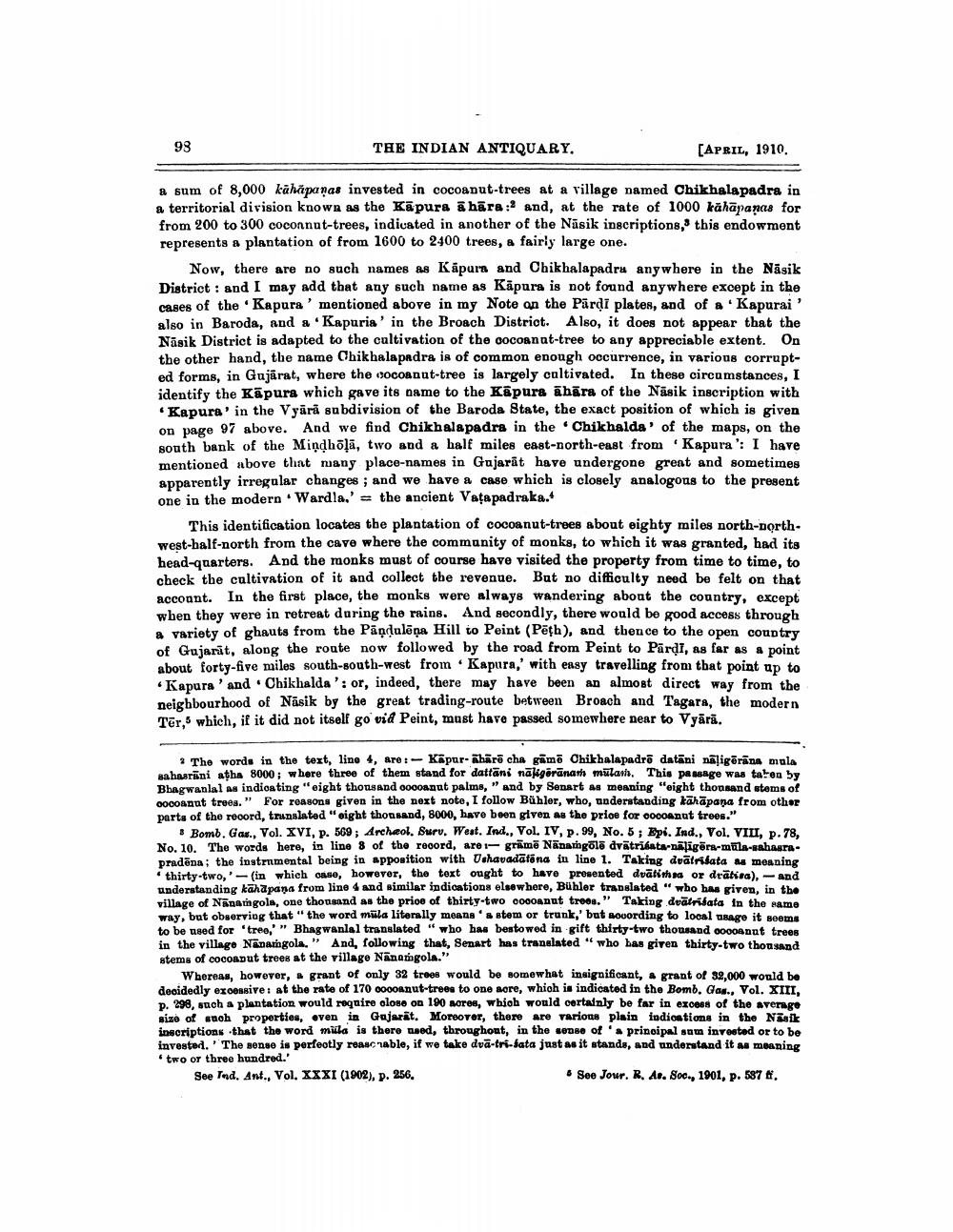________________
98
THE INDIAN ANTIQUARY.
[APRIL, 1910.
a sum of 8,000 kahapanas invested in cocoanut-trees at a village named Chikhalapadra in a territorial division known as the Kapura ahara: and, at the rate of 1000 kāhāpaņas for from 200 to 300 coconnut-trees, indicated in another of the Nasik inscriptions, this endowment represents a plantation of from 1600 to 2400 trees, a fairly large one.
"
Now, there are no such names as Kapura and Chikhalapadra anywhere in the Näsik District: and I may add that any such name as Kapura is not found anywhere except in the cases of the Kapura' mentioned above in my Note on the Pärdi plates, and of a Kapurai also in Baroda, and a 'Kapuria' in the Broach District. Also, it does not appear that the Nasik District is adapted to the cultivation of the cocoanut-tree to any appreciable extent. On the other hand, the name Chikhalapadra is of common enough occurrence, in various corrupted forms, in Gujarat, where the cocoanut-tree is largely cultivated. In these circumstances, I identify the Kapura which gave its name to the Kapura ahara of the Nasik inscription with 'Kapura' in the Vyara subdivision of the Baroda State, the exact position of which is given on page 97 above. And we find Chikhalapadra in the Chikhalda' of the maps, on the south bank of the Mindhōla, two and a half miles east-north-east from Kapura': I have mentioned above that many place-names in Gujarat have undergone great and sometimes apparently irregular changes; and we have a case which is closely analogous to the present one in the modern Wardla,' the ancient Vatapadraka.*
•
This identification locates the plantation of cocoanut-trees about eighty miles north-northwest-half-north from the cave where the community of monks, to which it was granted, had its head-quarters. And the monks must of course have visited the property from time to time, to check the cultivation of it and collect the revenue. But no difficulty need be felt on that account. In the first place, the monks were always wandering about the country, except when they were in retreat during the rains. And secondly, there would be good access through a variety of ghauts from the Pandulēna Hill to Peint (Peth), and thence to the open country of Gujarat, along the route now followed by the road from Peint to Pārdi, as far as a point about forty-five miles south-south-west from Kapura,' with easy travelling from that point up to Kapura' and Chikhalda': or, indeed, there may have been an almost direct way from the neighbourhood of Nasik by the great trading-route between Broach and Tagara, the modern Ter, which, if it did not itself go vid Peint, must have passed somewhere near to Vyārā.
2 The words in the text, line 4, are:- Kapur- ähäre cha game Chikhalapadre datāni nāļigērāna mula sahasrani aṭha 8000; where three of them stand for dattani naligērānam mulah. This passage was taken by Bhagwanlal as indicating "eight thousand cocoanut palms," and by Senart as meaning "eight thousand stems of oocoanut trees." For reasons given in the next note, I follow Bühler, who, understanding kahapana from other parts of the record, translated "eight thousand, 8000, have been given as the price for cocoanut trees."
8 Bomb. Gas., Vol. XVI, p. 569; Archeol. Surv. West. Ind., Vol. IV, p. 99, No. 5; Epi. Ind., Vol. VIII, p. 78, No. 10. The words here, in line 8 of the record, are grame Nanamgōlē dvātrisata-nāligēra-mula-sahasrapradena; the instrumental being in apposition with Ushavadātēna in line 1. Taking dvatisata as meaning thirty-two, (in which case, however, the text ought to have presented dvatima or drātisa), - and understanding kahapana from line 4 and similar indications elsewhere, Bühler translated "who has given, in the village of Nanamgola, one thousand as the price of thirty-two cocoanut trees." Taking deatrisata in the same way, but observing that "the word mula literally means 'a stem or trunk,' but according to local usage it seems to be used for 'tree,'" Bhagwanlal translated "who has bestowed in gift thirty-two thousand cocoanut trees in the village Nanamingola." And, following that, Senart has translated "who has given thirty-two thousand stems of cocoanut trees at the village Nanamgola."
Whereas, however, a grant of only 32 trees would be somewhat insignificant, a grant of 32,000 would be decidedly excessive: at the rate of 170 cocoanut-trees to one aore, which is indicated in the Bomb, Gas., Vol. XIII, p. 298, such a plantation would require close on 190 acres, which would certainly be far in excess of the average size of such properties, even in Gujarat. Moreover, there are various plain indications in the Näsik inscriptions that the word mula is there used, throughout, in the sense of a principal sum invested or to be invested. The sense is perfectly reasonable, if we take dva-tri-sata just as it stands, and understand it as meaning two or three hundred.'
See Ind. Ant., Vol. XXXI (1902), p. 256.
* See Jour. R. As. Soc., 1901, p. 587 f.




